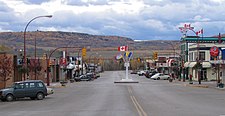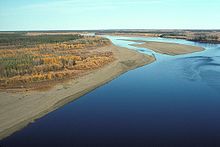Alaska - wilderness on the edge of the world
| Movie | |
|---|---|
| Original title | Alaska - wilderness on the edge of the world |
| Country of production | Germany |
| original language | German |
| Publishing year | 1966 |
| length | 89 minutes |
| Age rating | FSK 6 |
| Rod | |
| Director | Eugen Schuhmacher |
| script | Eugen Schuhmacher Freimut Kalden |
| production | Frank Kalden |
| music |
Hans Conzelmann Delle Haensch |
| camera | Eugen Schuhmacher Freimut Kalden |
| cut | Helga Kalden |
| occupation | |
| |
Alaska - Wilderness on the Edge of the World is a German documentary from 1966. It was shot by Eugen Schuhmacher and Freimut Kalden . The German actor Wolf Ackva acted as narrator . The film was released in German cinemas on May 27, 1966, had its TV premiere on First German Television in September 1972 and was released on DVD in November 2008.
background
In the course of his cinematic work, Eugen Schuhmacher made ten trips to Alaska. For the shooting of the film Alaska - Wilderness on the Edge of the World , Schuhmacher and Kalden visited the historical places of Alaska such as Sitka or the White Pass as well as the natural landscapes on the Mount McKinley massif or on the Kodiak Island in the spring and summer of 1965 . Eugen Schuhmacher wrote the book Alaska: Vast Land on the Edge of the Arctic , published in 1970, about his trips to Alaska .
action
The introduction briefly describes the history and geography of Alaska and shows recordings from a Russian cemetery and from a Russian Orthodox church service in St. Michaels Cathedral in Sitka . In further stations of the film it goes first from Dawson Creek in Canada over the Alaska Highway to Fairbanks and Anchorage . With the VW Beetle , the shoemaker drives past forests, lakes and mountains and gets beavers , mountain goats , caribou , grizzlies, Alaskan moose and a family of red foxes in front of the camera. One stop on the Alaska Highway is the town of Watson Lake , where tourists from all over the world have put up over 50,000 street, town and other signs.
On the Porcupine River , Eugen Schuhmacher shows totem poles and a block high-rise belonging to the Athapaskan Indians. In the next few scenes, Schuhmacher introduces areas devastated by forest fires and road builders earning $ 13,000 during their five months' work.
Afterwards Schuhmacher visits the Indian cemetery of Eklutna , northeast of Anchorage , which was built by Russian monks and is best known for its colorful ghost houses. Then the cities of Fairbanks and Anchorage are briefly introduced. At the gates of the city of Anchorage is the Lake Hood Seaplane Base with the largest seaplane base in the world. After a trip to the city of Juneau , Schuhmacher's next destinations are the Mendenhall Glacier and the Alaska Panhandle , which can only be reached by plane. The boat continues across the Juneau Icefield, past the Fairweather Glacier and the Elias chain to Glacier Bay . Schuhmacher can film huge glacier breaks in Glacier Bay. The film then goes into the gold rush in 1898 and the industrial forms of gold mining with the help of giant excavators, the so-called gold dredges . The White Pass and Yukon Railway continues to White Pass , an area where over 3,000 horses were tortured to death during the gold rush of 1898 and 1899. The next scenes show the agricultural strongholds of Alaska in the Tanana Valley near Fairbanks, on the Kenai Peninsula and on the Matanuska River near Anchorage. Shoemaker films wild musk ox on a reservation near the town of Fairbanks .
We continue by plane to Mount McKinley , which at 6,194 meters is the highest mountain in North America. At the Sanctuary River Campground below Mount McKinley in Denali National Park , Shoemaker films moose, ground squirrels , tree prickers , red grouse and grizzly bears . In the interior of the national park, the vegetation becomes more sparse and on the steep slopes of the Polychrome Pass shoemaker marmots and bighorn sheep face the camera. After the migration of the caribou herds in Denali National Park, it goes to Kodiak Island in the Shelichow Strait , where the Kodiak bears arrive at the end of July during the main spawning season of the salmon and feed exclusively on salmon and its roe. After taking pictures of the Knik glacier panorama, it is finally in the Arctic Circle , where Eugen Schuhmacher meets Eskimos hunting seals and building igloos .
Awards
The film received the rating “ valuable ” from the Wiesbaden film evaluation agency . He won the Grand Prix at the Trento Festival in 1966.
Reviews
The Lexicon of International Films wrote: “Conventionally designed documentary about the wildlife and natural beauty of Alaska. Little can be learned about culture and society ”.
Web links
- Alaska - Wilderness on the edge of the world in the Internet Movie Database (English)
Individual evidence
- ↑ Alaska - Wilderness on the Edge of the World. In: Lexicon of International Films . Film service , accessed March 2, 2017 .




